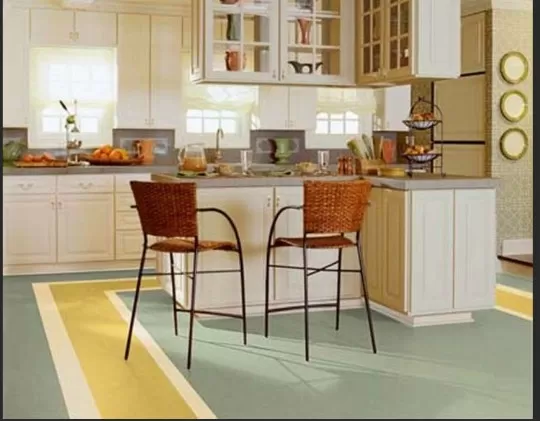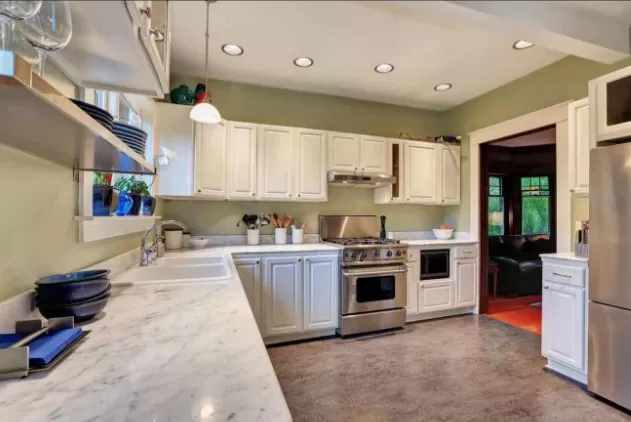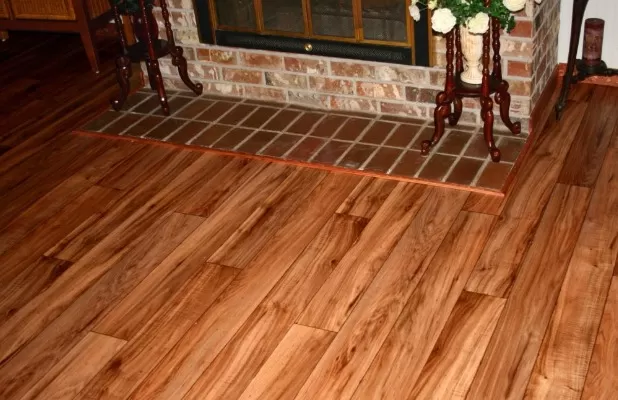Unveiling Linoleum Flooring’s Hidden Benefits. One of the key factors contributing to linoleum’s longevity is its exceptional durability.
Crafted from natural materials, including linseed oil, wood flour, cork dust, and mineral pigments, linoleum exhibits remarkable resilience. Its composition allows it to withstand heavy foot traffic, making it an ideal choice for high-traffic areas in residential and commercial spaces alike. Linoleum is renowned for its ability to resist scratches, dents, and wear, ensuring that it maintains its visual appeal and structural integrity over time.
Enhancing Durability: Maximizing the Lifespan of Linoleum Flooring

When it comes to durability, linoleum flooring stands out as a reliable choice.
Unlike Vinyl Flooring, linoleum can last for over 40 years with proper care and maintenance, surpassing the average lifespan of other flooring options. Manufacturers often offer warranties of 25 years or more, but taking the extra steps to protect and maintain your linoleum can significantly extend its longevity.
One of the key factors contributing to linoleum’s exceptional lifespan is its inherent construction.
Unlike tile flooring, where the color and pattern are merely printed on the surface, linoleum possesses color and pattern throughout the entire width of the material. This inherent colorfastness ensures that the flooring retains its vibrant appearance even after years of use.
To safeguard your linoleum flooring from darkening or developing a yellow tinge, it’s important to select a product that includes a protective coating.
This additional layer, applied by manufacturers, acts as a barrier against the effects of direct sunlight, known as “ambering. ” However, it’s essential to note that not all linoleum options come with this protective coating, so be sure to choose one that offers this feature.
The protective top layer not only shields the surface from discoloration but also enhances the floor’s resilience against dirt and scuffs.
Nevertheless, it’s important to remember that linoleum is not completely impervious to damage. Avoiding dents and tears caused by sharp objects such as high heels, metal furniture legs, or dropped knives is crucial in maintaining its pristine condition.
By adhering to proper care practices and taking preventive measures, you can ensure that your linoleum flooring retains its durability and visual appeal for decades to come.
With its impressive lifespan and resilience, linoleum proves to be a reliable flooring option that stands the test of time.
Water Resistance: Linoleum’s Advantage in Moisture-Prone Spaces
In addition to its durability, linoleum flooring offers a distinct advantage in terms of water resistance, setting it apart from options such as wood.
This quality makes it a wise choice for areas that frequently encounter wet shoes, snowy boots from the outdoors, or occasional splashes, including kitchens and bathrooms. Unlike wood flooring, linoleum can withstand water exposure without immediate damage.
While linoleum is resistant to water, it’s important to note that it should never be fully immersed in water.
Excessive moisture can lead to undesirable consequences such as curling of edges, corners, or seams. Instances like floods, burst pipes, or prolonged exposure to high humidity can potentially cause damage to linoleum flooring.
In such situations, it’s advisable to explore alternative options that offer higher levels of waterproofing, such as researching comparable vinyl tile alternatives.
However, for spaces that experience regular foot traffic, occasional spills, and general moisture exposure, linoleum remains a reliable and practical choice.
Its inherent water resistance makes cleaning and maintenance easier, as it can withstand the rigors of everyday life and remain resilient against common water-related challenges.
By selecting linoleum for areas prone to moisture, you can confidently enjoy a flooring solution that combines durability and water resistance, providing a practical and visually appealing foundation for your home or commercial space.
Effortless Maintenance: Keeping Linoleum Flooring Pristine

When it comes to maintaining your flooring, linoleum stands out as one of the easiest materials to clean and care for.
With a few simple steps, you can ensure that your linoleum flooring remains in excellent condition for years to come.
The protective top layer of linoleum acts as a shield against dirt and scuffs, but regular cleaning is still necessary.
To keep your linoleum looking its best, use mild, non-ammonia-based cleansers. A quick sweep or vacuum on a regular basis will help remove abrasive dirt particles that could potentially scratch the surface over time.
Additionally, occasional damp mopping with warm water will help maintain its cleanliness.
In the event of stains, they can be easily tackled with a rag and mild detergent.
Thanks to linoleum’s construction, where the color runs all the way through the material, any stains or scratches can be buffed out, allowing you to restore the floor’s original appearance.
It’s important to note that linoleum without a factory-applied protective coating against ambering will require additional maintenance.
To prevent yellowing and protect the surface from scratches and Water Damage, it is recommended to clean and wax this type of linoleum every two or three years. This process helps maintain its visual appeal and ensures the longevity of the flooring.
By following these simple maintenance practices, you can effortlessly keep your linoleum flooring looking pristine.
Its easy-to-clean nature and the option to refinish damaged areas make it a convenient choice for those seeking a low-maintenance and long-lasting flooring solution.
Sustainable Choice: Linoleum’s Eco-Friendly Attributes
Linoleum not only offers durability and aesthetic appeal but also boasts impressive eco-friendliness, making it a sustainable flooring choice.
The very name “linoleum” reflects its all-natural origins, derived from the Latin words “linum,” meaning flax or linen, and “oleum,” meaning oil. This natural composition sets linoleum apart from synthetic flooring materials and contributes to its eco-friendly characteristics.
One notable aspect of linoleum’s sustainability is its recyclability.
At the end of its lifespan, typically after 25 to 40 years, linoleum can be easily recycled. This means you can dispose of it without guilt, knowing that it can be repurposed instead of ending up in a landfill.
Recycling facilities, particularly energy-recycling incineration plants, can process used linoleum effectively. In cases where the discard pile is smaller, you may even consider composting it for your garden, similar to how you would use mulch or wood chips.
Additionally, linoleum’s all-natural composition ensures that it does not emit harmful VOC (volatile organic compounds) emissions.
VOCs are chemicals that can have adverse effects on indoor Air Quality and human health. By choosing linoleum, you can enjoy a flooring option that maintains excellent indoor air quality and contributes to a healthier living environment.
These eco-friendly attributes make linoleum a responsible choice for those seeking sustainable flooring solutions.
From its natural origins to its recyclability and low VOC emissions, linoleum aligns with environmentally conscious practices, allowing you to create a beautiful and sustainable space with peace of mind.
Limitless Choices: The Abundance of Linoleum Options

When it comes to linoleum flooring, the options are truly vast, offering a multitude of colors, styles, patterns, and installation methods.
This diversity allows you to find the perfect linoleum solution to suit your aesthetic preferences and practical needs.
First and foremost, linoleum presents an extensive array of colors, styles, and patterns.
Whether you desire a floor that mimics the natural look of wood, stone, or marble, or you prefer vibrant and bold colors, linoleum has you covered. With advancements in technology, manufacturers have created designs that closely resemble the authentic textures and appearances of these materials, providing a wide range of choices to suit any interior design scheme.
Furthermore, linoleum offers various options for installation and overall appearance.
Sheet linoleum flooring stands out as the option with the greatest versatility, offering an extensive variety of colors and patterns. It comes in large rolls, making it suitable for covering expansive, open areas seamlessly.
If you prefer the look of traditional tile flooring but seek a more affordable alternative, tile linoleum flooring is an excellent choice.
It closely resembles ceramic, porcelain, and stone tiles while providing the cost-effectiveness and durability that linoleum offers.
For a convenient and straightforward installation process, click-and-lock linoleum is designed to be used as part of a floating floor system.
Available in tile or plank form, this type of linoleum snaps into place on a floor frame, eliminating the need for additional adhesive. It provides a hassle-free installation experience while maintaining the durability and visual appeal of linoleum.
With such a myriad of options available, you can find the perfect linoleum flooring solution that aligns with your design preferences, budget, and installation requirements.
Whether you seek versatility, affordability, or convenience, linoleum offers a wealth of choices to create the ideal flooring for your space.
*The information is for reference only.